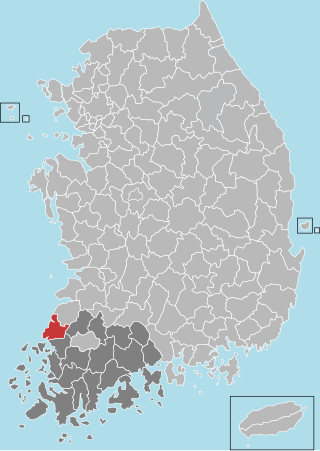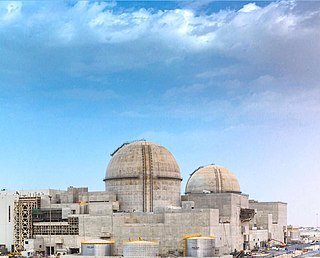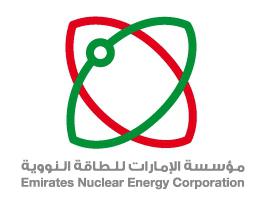Related Research Articles

Yeonggwang County (Yeonggwang-gun) is a county in South Jeolla Province, South Korea.
Korea Hydro & Nuclear Power is a subsidiary of the Korea Electric Power Corporation (KEPCO). It operates large nuclear and hydroelectric plants in South Korea, which are responsible for about 27 percent of the country's electric power.
Korea Electric Power Corporation, better known as KEPCO (Korean: 켑코) or Hanjeon (Korean: 한전), is the largest electric utility in South Korea, responsible for the generation, transmission and distribution of electricity and the development of electric power projects including those in nuclear power, wind power and coal. KEPCO, through its subsidiaries, is responsible for 93% of Korea's electricity generation as of 2011. The South Korean government owns a 51.11% share of KEPCO. Together with its affiliates and subsidiaries, KEPCO has an installed capacity of 65,383 MW. On the 2011 Fortune Global 500 ranking of the world's largest companies, KEPCO was ranked 271. KEPCO is a member of the World Energy Council, the World Nuclear Association and the World Association of Nuclear Operators. As of August 2011, KEPCO possesses an A+ credit rating with Fitch Ratings, while Moody's has assigned KEPCO an A1 stable rating.

The Czech Republic operates two nuclear power plants: Temelín and Dukovany. As of 2019 the government intends to increase the share of nuclear electricity production from 30 % to 58 %. To this end, a new reactor is to be constructed at the Dukovany site, which will replace older units by 2035. New capacities are also expected to be added at the Temelín site.
Nuclear power is a major power source in South Korea, providing 29% of the country's electricity. The total electrical generation capacity of the nuclear power plants of South Korea is 20.5 GWe from 23 reactors, equivalent to 22% of South Korea's total electrical generation capacity.

The Mihama Nuclear Power Plant is operated by The Kansai Electric Power Company, Inc. and is in the town of Mihama, Fukui Prefecture, about 320 km west of Tokyo. It is on a site that is 520,000 m2 of which 60% is green space. Mihama - 1 was commissioned in 1970.

The Ōi Nuclear Power Plant, also known as Oi or Ohi, is a nuclear power plant located in the town of Ōi, Fukui Prefecture, managed by the Kansai Electric Power Company. The site is 1.88 square kilometers. Ōi Units 3 and 4 were taken offline in September 2013. In December 2017 Kansai Electric Power announced that it will decommission reactors no. 1 and 2 because of their age and the difficulty of making safety upgrades within their small containment vessels. Unit 3 was restarted on 14 March 2018, and unit 4 was restarted on 9 May 2018.

The Takahama Nuclear Power Plant is a nuclear power plant located in the town of Takahama, Ōi District, Fukui Prefecture. It is owned and operated by the Kansai Electric Power Company and is on a site with an area of about 1 km2. The four pressurized water reactors give the plant a total gross electric capacity of 3,392 MW and average yearly production of 22,638 GWh.

The Kori Nuclear Power Plant is a South Korean nuclear power plant located in Kori, a suburban village in Busan. It is the world's second largest fully operational nuclear generating station by total reactor count and the number of currently operational reactors since 2016, after it exceeded in nameplate capacity Canada's Bruce Nuclear Generating Station. It is owned and operated by Korea Hydro & Nuclear Power, a subsidiary of KEPCO. The first reactor began commercial operation in 1978 and operated until 2017 when it was decommissioned. Units 2, 3, and 4 started commercial operations in the 1980s. All reactors on site are pressurized water reactors.

The Wolseong Nuclear Power Plant, or Wolsong, is a nuclear power plant located on the coast near Nae-ri, Yangnam-myeon, Gyeongju, North Gyeongsang province, South Korea. It is the only South Korean nuclear power plant operating CANDU-type PHWR. Korea Hydro & Nuclear Power owns the plant. These reactors are capable of consuming multiple types of fuel, including wastes from South Korea's other nuclear plants.

The Hanul Nuclear Power Plant is a large nuclear power station in the North Gyeongsang Province of South Korea. The facility has six pressurized water reactors (PWRs) with a total installed capacity of 5,881 MW. The first went online in 1988. In the early 2000s it was the third largest operational nuclear power plant in the world and the second largest in South Korea. The plant's name was changed from Uljin to Hanul in 2013.

The Hanbit Nuclear Power Plant is a large nuclear power station in the Jeollanam-do province of South Korea. The facility runs at an installed capacity of 5,875 MW. The power station is currently ranked as the fifth largest nuclear power station in the world. The plant's name was changed from Yeonggwang NPP to Hanbit in 2013 at the request of local fishermen.

The United Arab Emirates is installing nuclear-powered plants to meet their electricity demand, which is estimated to increase from 15 GWe to over 40 GWe in 2020. In December 2009, the US and UAE signed a Section 123 Agreement for peaceful nuclear cooperation. The UAE has also signed Nuclear Non-Proliferation Treaty (NPT), along with the additional protocol.
KEPCO E&C is a power plant design and engineering company in South Korea. It was established in 1975 as a public enterprise. KEPCO E&C engages in designing, engineering, and constructing nuclear and fossil power plants. The company operates as a subsidiary of Korea Electric Power Corporation (KEPCO).
Vietnam is considering developing nuclear power for peaceful purposes based on modern, verified technology since 1995, and firm proposals surfaced in 2006. In November 2016 Vietnam suspended its nuclear power plans. In 2022 industry and trade minister Nguyen Hong Dien announced that developing nuclear power is an “inevitable trend” for Vietnam, and will help the country to become carbon neutral by 2050.

The APR-1400 is an advanced pressurized water nuclear reactor designed by the Korea Electric Power Corporation (KEPCO). Originally known as the Korean Next Generation Reactor (KNGR), this Generation III reactor was developed from the earlier OPR-1000 design and also incorporates features from the US Combustion Engineering (C-E) System 80+ design. Currently in South Korea there are 3 units in operation, and 3 units in construction. Four units are completed and in commercial operation in the United Arab Emirates at Barakah.
Moorside nuclear power station is proposed for a site near Sellafield, in Cumbria, England. The original plan by NuGeneration, a British subsidiary of Toshiba-owned Westinghouse Electric Company, had the station coming online from 2024 with 3.4 GW of new nuclear capacity, from three AP1000 reactors. Work up to 2018 would include acquiring the site licence, the development consent order, and other required permits and permissions to start work. Site preparation was to take two years, up to 2020.

The Emirates Nuclear Energy Corporation is the entity responsible for the deployment and ownership of nuclear energy plants in the United Arab Emirates (UAE).
The Cheonji Nuclear Power Plant (Korean: 천지원자력발전소) is a planned South Korean nuclear power plant located in rural Yeongdeok County. Cheonji would be the first plant to implement the uprated APR+ design with 1500MWe output. The first unit, Cheonji-1, was scheduled to enter commercial operation in 2026, with the sister unit Cheonji-2 to follow in 2027. However, in the wake of the election of Moon Jae-in, who campaigned on an anti-nuclear platform, plans to acquire the land and proceed with license application were put on hold in 2017. The two units are, as of 2023, scheduled to be completed 2028 and 2029, respectively.
References
- ↑ "OPR1000". KEPCO. Archived from the original on 21 December 2013. Retrieved 17 December 2013.
- ↑ Goldberg, Stephen; Rosner, Robert (2011). Nuclear Reactors: Generation to Generation (PDF). American Academy of Arts & Sciences. p. 5. ISBN 978-0-87724-090-7 . Retrieved 7 Jan 2014.
- ↑ Kim, Han Gon (4 July 2011). "GEN III/GENIII+ : Korean Perspective - APR1400" (PDF). Korea Hydro & Nuclear Power Co. Retrieved 17 December 2013.
- ↑ Lee, Sang-Seob; Kim, Sung-Hwan; Suh, Kune-Yull (October 2009). "The Design Features of the Advanced Power Reactor 1400". Nuclear Engineering and Technology. 41 (8): 995–1004. doi: 10.5516/NET.2009.41.8.995 .
- 1 2 "Korea, Republic of". IAEA Power Reactor Information System. 2015. Retrieved 11 March 2015.
- 1 2 3 "Korea probes forged quality certificates". World Nuclear News. 7 November 2012. Retrieved 11 March 2015.
- 1 2 3 4 "New component issues idle Korean reactors". World Nuclear News. 28 May 2013. Retrieved 11 March 2015.
- ↑ "Nuclear Power in the United Arab Emirates". World Nuclear Association. December 2013. Archived from the original on 2016-01-18. Retrieved 2014-01-07.
- ↑ "Nuclear reactor halts operation due to malfunction". Yonhap News. 2 October 2012. Retrieved 11 March 2015.
- ↑ "South Korean units restart after probe". World Nuclear News. 2 January 2013. Retrieved 11 March 2015.
- ↑ "Recabling delays Shin Kori start ups". World Nuclear News. 18 October 2013. Retrieved 11 March 2015.
- ↑ "Korean reactors cleared for restart". World Nuclear News. 2 January 2014. Retrieved 11 March 2015.
- ↑ "Grid connection for South Korean reactor". World Nuclear News. 26 February 2015. Retrieved 11 March 2015.
- ↑ "South Korean reactor enters commercial operation". World Nuclear News. 24 July 2015. Retrieved 29 January 2016.
- ↑ "South Korea's APR1000 certified for European use by EUR". World Nuclear News. 2 March 2023. Retrieved 3 March 2023.
- ↑ "APR1000 – Advanced Power Reactor 1000" (PDF). Korea Hydro and Nuclear Power Corporation. IAEA. 2019. Retrieved 3 March 2023.
- ↑ "Korea advances Czech nuclear deal despite Westinghouse challenge". Nuclear Engineering International. 28 August 2024. Retrieved 29 August 2024.